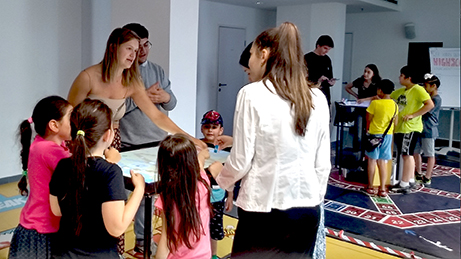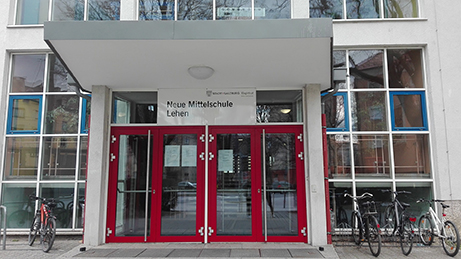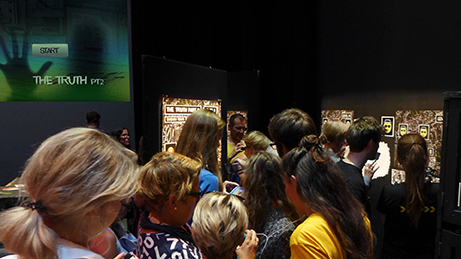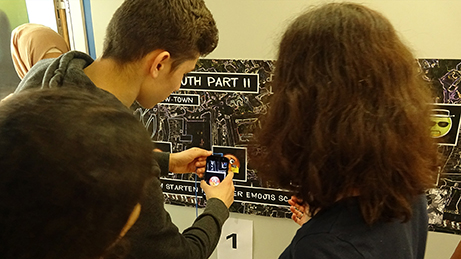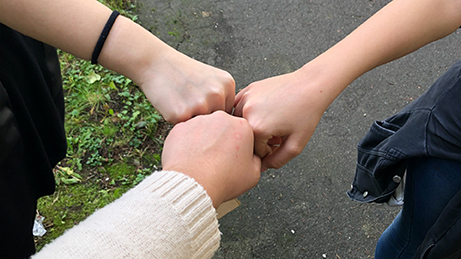SCHNITT # STELLEN: Artistic Research
Sonja Prlić, Karl Zechenter
Documentation
Concepts, Approaches, Themes
The approach of artistic research in this project was oriented towards the methods of Participatory Art Based Research (PABR), in which collaborative research with social actors occupies a central place. With this project we would like to expand the discourse on artistic research and participation to include aspects of digital games and digital media.
Researching with the students
Two aspects formed the framework of the conception of the art projects: On the one hand, the work stages were to offer space for new approaches and, on the other hand, for joint discussion. The new approaches offered the possibility to change work tasks and roles in the project.
In the discussion (and the joint artistic work) the framework for the encounter and reflection of the different creative and media experiences and their interactions emerged. The individual project steps were conceived in such a way that results were discussed together and decisions were made about the progress of the project, or that the students – with the exception of highly specialized work steps (parts of the programming) – were involved and co-decisive in all production stages.
Therefore, creative work was reflected upon during the entire process in various work stages, in-depth discussions were held with the students during the production period on individual focal points chosen by the artists (media experience, aesthetic experiences, collaboration experiences), and the results created or the project progress were discussed at the conclusion in each case. In this way, the students reflected on their collaborative creative work and their own role in it, partly in creative processes over the entire project.
The observations of the artists were documented in research diaries and memory protocols, e.g. of group discussions. In addition, at the beginning of the respective practical projects, the students created workbooks in which they recorded their own exploratory and experiential tasks.
Framework Concepts of Artistic Research
The research assumptions focused on dialogical practices, the exploration and appropriation of new spaces in schools, art institutions and public spaces, collaborations between media artists and young people, and above all the participation of young people themselves as experts in digital media use.
Research diaries and observation protocols were used as data collection instruments, and interviews with experts and evaluations were initiated by the board. For the artistic research, elements from action research were prioritized, among others in group discussions of the participants, in the joint design of the product and the process, and in the joint presentation.
Mixed Realities – Participatory Artistic Research and Digital Games
Artistic research that includes digitality and participation can activate its potential if the expert knowledge of the young people is consciously addressed. For the project work, this means that after a phase of getting to know each other and building trust, the process opens up spaces so that the young people can contribute this expert knowledge and from there new perspectives can be opened up for the further process. This includes the examination of knowledge content, artistic formats as well as certain skills and creative ideas of the young people.
As an artistic exploratory approach, we brought in approaches from augmented reality as a starting point for the collaborative work. In the course of the project, through the exchange of the experiences of artists* and young people, very unique game formats emerged that mixed more traditional augmented reality approaches with aspects of the young people’s media experiences and creative ideas. One of the results of the artistic research is that the participatory work with games leads to new artistic formats that expand the canon of previous art forms with new approaches. The resulting games can be described as mixed reality games in the truest sense of the word, because they were created in an exchange of experiences between young people and artists and, as new artistic formats, mix youth culture, contemporary media art, games and everyday experiences.
Focus on creative teamwork
The artistic research process was characterized by intensive engagement with the young people and their media and everyday experiences. The research was structured around various focal points (locations, media, and aesthetics) that framed the intersections between youth cultures and media art and the synergies and areas of friction that emerged in the collaboration. In the artistic research work, we chose a process approach that integrated the completion of a playable and presentable artwork into the joint engagement of young people and artists, and included not only the creation and development phases but also the presentation of the artwork and the experiences gained through public presentations, awards ceremonies, press coverage, etc. as another central part of the research.
This approach of going through all phases of an artistic project together has proven productive both in terms of the goal of integrating cultural institutions and their audiences into the process and of developing approaches to cultural participation among young people.
The ARGEkultur Salzburg, for example, integrated the game presentations into their regular festival program and in this way opened the house to new artistic formats and target groups; beyond the presentations, they supervised the young people in film shoots on site, with technology and event set-up, and made efforts to further integrate the young people into their ongoing program. ARGEkultur was thus not only an event partner but part of the joint research process. With the artistic director, Sebastian Linz, who was on the board of the project, we were able to reflect on the experiences in the presentations and at the same time discuss perspectives for further developments and openings of the house to young target groups. Such a long-term and intensive cooperation of cultural institution and research project with young people would be desirable for further projects of this form, as only then can questions of cultural participation be worked on sustainably.
Outcomes of the artistic research
The long-term project work with the young people, which lasted a whole school year in each case, promoted intensive relationship work and trust-building between the young people and the artists, which made it possible to enter into the process with an open mind, to respond to the young people’s ideas and to explore artistic, technological and pedagogical implementation possibilities in order to realize them.
This long-term nature meant that, in the course of the project work, it was possible to incorporate both various interests and talents of the young people that would not emerge in the form possible here in shorter workshops or in the classroom. A year-long game development within the framework of a subject raised questions regarding the design of lessons in general and the potentials and requirements that can be found in interdisciplinary project work: Project work in this form holds potentials for the individual support and development of young people, who acquire different competencies within a process, experience teamwork and cooperation, and experience creativity. At the same time, the identification with games as artistic media and the presentation of one’s own results enables self-confidence and leads to an expansion of the young people’s experiences outside the framework of school.
As our project shows, however, this requires personnel as well as spatial and financial resources and the openness of a school to make such processes possible. With the Mittelschule Lehen, we had a school as a partner that showed itself to be extremely open and interested in these processes. It would be desirable to permanently include this kind of project work between digital art and education in everyday school life, to provide public funding for it, and to enable further training for teachers and artists.


